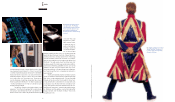Sennheiser 2012 Annual Report Download - page 21
Download and view the complete annual report
Please find page 21 of the 2012 Sennheiser annual report below. You can navigate through the pages in the report by either clicking on the pages listed below, or by using the keyword search tool below to find specific information within the annual report.
2,800 Hz
2,800 Hz
40
VOICE TRAINING
41
Ron Anderson’s house in South Miami is a repository of
pop and rock history, walls lined top to bottom with
gold and platinum albums, signed posters and photo-
graphs of seemingly every major artist in the world – Alicia
Keys, Selena Gomez, Maroon 5, Red Hot Chili Peppers, Avril
Lavigne, Seal, Pink and the Iglesias family. They have all
stood by Anderson’s nine-foot Knabe grand piano and re-
ceived help from the erstwhile operatic tenor-turned-vocal-
coach, whose fabled technique and persuasive manner can
improve even the most damaged of vocals.
A tall, impeccable man with kingly bearing, Ander-
son spends as much time touring with acts as he does teach-
ing from his studio, often via video. He can give as many as
12 one-hour lessons in one day. This Friday morning found
him at 8 a.m. teaching young Russian tenor Alexander Ko-
gan, who was preparing to tour with Julio Iglesias. Later
came remote video lessons with Janet Jackson and with Ali-
cia Keys, who was preparing for her national anthem perfor-
mance during the Super Bowl. How does Anderson know
what to do with such a vast array of voices and styles? Read
on for the secrets behind one of the world’s most noted
vocal coaches.
So many singers are successful and don’t have great voices.
And so many singers have beautiful voices and never be-
come successful. What makes the difference?
The entire package. You have to have the personality, you have
to have the mentality and you have to have the talent. But the
main thing is, you have to be you and nobody else. Once you
have that, and you have that package, it’s unstoppable.
Let’s say I have a great voice. Why do I need to come to you?
You come to me because I can guide you. Each person has
their own thing, and I bring out the best in them. Pop artists
come to me because they don’t have the training. And once
they start to achieve the training, the registers open up, the
voice’s range goes to where it should go. Now, in the classical
world, we’ve already got that kind of training. So we have to
have another discipline. We have to take care of our bodies,
and I bring that back into the pop world. They do a lot of
things that they shouldn’t be doing.
How do you approach your lessons?
The new ones I approach in person.
I think it’s very important, because
you have to study the anatomy.
You study the coordinations, you
have to know the sounds and you
have to see where the resonances
are placed. After that, half of my
business is online.
What advice do you give all your
singers?
First of all, sleep. Sleep is the only thing that truly rejuve-
nates the voice. Watch your diet. Stay away from a lot of
things that cause acid reflux. What time you eat. Don’t go to
bed for at least three hours after you’ve eaten. Watch your
medication. Drugs. If I run into that, I’m off the tour. And I’ve
gone off a couple. The real enemy is the cold.
Technically speaking, what is the biggest mistake singers
make?
They over-sing. They think power is everything. You never
sacrifice beauty for power; you always stay in control. You
never allow the music to take you away. That’s a big
problem, and we all have that because we get involved in a
performance. You start to get hoarse, the voice starts to get
dry and immediately you have to start backing off. If you
don’t, you’ll never make it through the concert.
You were with the show choir Young Americans as a teen,
and at 17 you had your first record deal with a boy group.
But then, you hurt your voice and …
… I couldn’t even talk for eight months! It was like, your life’s
over. Literally. That’s the way I looked at it and I was really
angry, because we had studied. But I found out that most of
these teachers had no clue what they were doing, because
many voice teachers are choir singers. They’ve never had to
carry a show. Ever.
You then went to two renowned voice teachers – Fritz Zweig
and Lotte Lehmann – to get your voice fixed. You took lots
BRILLIANCE & RADIANCE
2,800
Hz: this is the approximate frequency
range where the singing formant of
trained opera tenors lies. It is an
effect that gives their voices a light
metallic ringing. Enrico Caruso and
Plácido Domingo had this formant,
and Ron Anderson developed it in
himself with hard work. With this
type of powerful projection, a prac-
ticed “Heldentenor” can belt out his
songs over the orchestra pit – without
the sound getting stuck in the thicket
of instrumentation. If laypeople try
this, they will fail – even if they sing
in a choir every week.
f1. “Power isn’t everything” –
Anderson prepares Russian tenor
Alexander Kogan (right) for his
tour with Julio Iglesias.
























